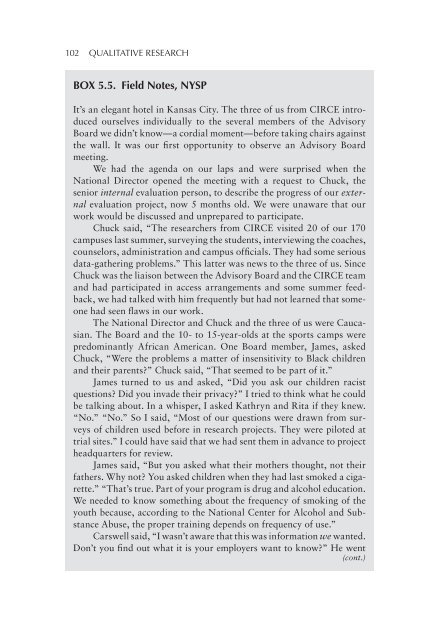How Things Work - Doha Academy of Tertiary Studies
How Things Work - Doha Academy of Tertiary Studies
How Things Work - Doha Academy of Tertiary Studies
Create successful ePaper yourself
Turn your PDF publications into a flip-book with our unique Google optimized e-Paper software.
102 QUaLItatIVe ReSeaRCH<br />
BOX 5.5. Field Notes, NYsP<br />
It’s an elegant hotel in Kansas City. The three <strong>of</strong> us from CIRCE introduced<br />
ourselves individually to the several members <strong>of</strong> the Advisory<br />
Board we didn’t know—a cordial moment—before taking chairs against<br />
the wall. It was our first opportunity to observe an Advisory Board<br />
meeting.<br />
We had the agenda on our laps and were surprised when the<br />
National Director opened the meeting with a request to Chuck, the<br />
senior internal evaluation person, to describe the progress <strong>of</strong> our external<br />
evaluation project, now 5 months old. We were unaware that our<br />
work would be discussed and unprepared to participate.<br />
Chuck said, “The researchers from CIRCE visited 20 <strong>of</strong> our 170<br />
campuses last summer, surveying the students, interviewing the coaches,<br />
counselors, administration and campus <strong>of</strong>ficials. They had some serious<br />
data-gathering problems.” This latter was news to the three <strong>of</strong> us. Since<br />
Chuck was the liaison between the Advisory Board and the CIRCE team<br />
and had participated in access arrangements and some summer feedback,<br />
we had talked with him frequently but had not learned that someone<br />
had seen flaws in our work.<br />
The National Director and Chuck and the three <strong>of</strong> us were Caucasian.<br />
The Board and the 10- to 15-year-olds at the sports camps were<br />
predominantly African American. One Board member, James, asked<br />
Chuck, “Were the problems a matter <strong>of</strong> insensitivity to Black children<br />
and their parents?” Chuck said, “That seemed to be part <strong>of</strong> it.”<br />
James turned to us and asked, “Did you ask our children racist<br />
questions? Did you invade their privacy?” I tried to think what he could<br />
be talking about. In a whisper, I asked Kathryn and Rita if they knew.<br />
“No.” “No.” So I said, “Most <strong>of</strong> our questions were drawn from surveys<br />
<strong>of</strong> children used before in research projects. They were piloted at<br />
trial sites.” I could have said that we had sent them in advance to project<br />
headquarters for review.<br />
James said, “But you asked what their mothers thought, not their<br />
fathers. Why not? You asked children when they had last smoked a cigarette.”<br />
“That’s true. Part <strong>of</strong> your program is drug and alcohol education.<br />
We needed to know something about the frequency <strong>of</strong> smoking <strong>of</strong> the<br />
youth because, according to the National Center for Alcohol and Substance<br />
Abuse, the proper training depends on frequency <strong>of</strong> use.”<br />
Carswell said, “I wasn’t aware that this was information we wanted.<br />
Don’t you find out what it is your employers want to know?” He went<br />
(cont.)

















